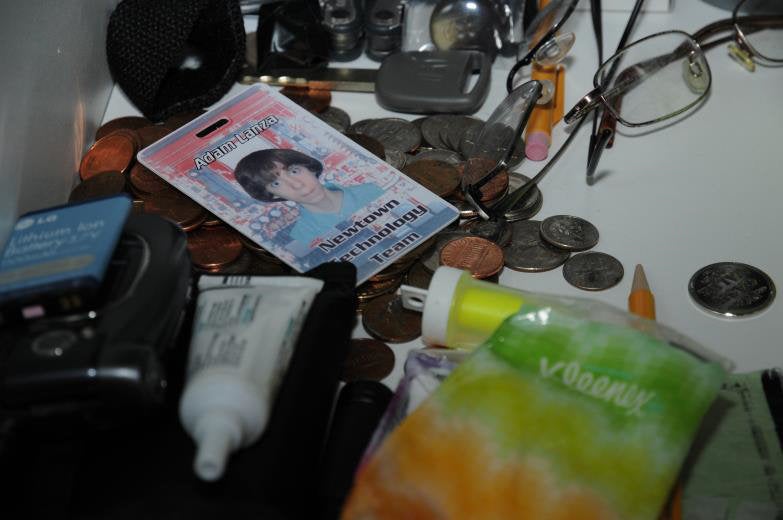
Friday night was supposed to be a celebration, a moment of young man levity after a nine-month stretch in which Avon Ball Jr. had worked to turn his life around.
Ball, 26, was finally, “off the box,” Baltimore-speak for the court-ordered electronic monitoring device that would be legally removed from his leg. Ball had spent the nine months getting a job, enrolling in school and following court orders to stay away from his girlfriend and be home by 8 p.m. each night. Before that, he served nearly four years in prison for assault.
Ball, finally free and clear on Friday, decided to hit a downtown Baltimore club with a friend and celebrate. He never made it home.
Ball and his friend were shot multiple times a few blocks from the club, said Ball's father, Avon Ball Sr. Ball was killed. His friend was wounded. The two men had been trying to get away from the club after a tense situation turned into an all-out argument, said the father, who had few details.
In the days surrounding Friday's mass shooting in Newtown, Conn., the kind of gun violence that takes one or two lives at a time -- widely considered ordinary in big cities -- continued across the country. From Dec. 10 to Monday, four people were killed by guns in Chicago, three in Boston and four in Baltimore, according to local police and medical examiners. The dead included Avon Ball Jr., Michael Robinson, Shawn Taylor and Ronald Dias. Some became the subject of stories in their local newspapers. Some became dots on a crime map.
All were young, ages 16 to 36. All but one were males and either black or Latino. Mass shootings -- in Aurora, Colo.; Tucson, Ariz.; Virginia Tech; and on Friday, in both Newtown, Conn., and Birmingham, Ala., grab headlines. But the slow trickle of gun deaths that took Ball’s life and others in the last week is the unabated violence that makes the United States one of the developed world's deadliest countries.
From 2001 to 2010, about 270,000 people were shot and killed in the U.S., the Los Angeles Times reported. These figures include homicides, accidents and suicides. But homicides alone put the U.S. in league with countries such as Mexico and Colombia, according to United Nations data.
“This is a country riddled with multiple gun tragedies,” said Robert Sampson, a Harvard University sociologist who studies crime and its effects on cities and neighborhoods. “There is the sudden and concentrated tragedy of Newtown, but there is also this ongoing, steady slow drip of tragedies in so many communities that don’t share the spotlight. America’s gun violence problem, as I see it, is a problem of both steady violence and mass shootings.”
In the 1960s, gun violence in the U.S. began to climb precipitously across the country, peaking in crack-ravaged cities in the late-1980s and early-1990s. After that, U.S. gun deaths began to slide. But that slope is part of a larger global decline, leaving the U.S. with few peers in gun violence.
“The other Western countries really saw a significant drop-off, making us still very violent in comparison,” said Sampson.
Data compiled by the United Nations' Office on Drugs and Crime confirms Americans are living with greater risk of gun-related death than are residents of other developed countries. From 2007 to 2009, the U.S. averaged 10,987 homicides per year by firearm, compared with an average of 182 in Germany, 75 in Spain and 47 in the United Kingdom. Mexico averaged 5,980 annual homicides by firearm during the period. Colombia averaged 13,174.
In the U.S., 8,583 of 12,664 murder victims in 2011 were killed by firearms, according to FBI data. California and Texas had the most murders by firearm in 2011, with 1,220 and 699, respectively.
Roseanna Ander, executive director of the University of Chicago Crime Lab, said the U.S. is an outlier in lethal violence among developed countries. Other countries have similar rates of rape and battery, Ander said, but because so much American violence includes guns, the rate of death is much higher.
Ander pointed to the incident that took place at a China school the same day of the Newtown, Conn. shooting. A man with a knife attacked and injured 22 children and one adult outside a primary school in Central China. None of the victims died.
A Bureau of Justice Statistics report in October shows violence of all kinds rose 17 percent in 2011 from the year before. Sampson said that's due to both the number of mass shootings and the steady tide of shooting deaths and woundings, happening one, two or three at a time.
In Boston, a jury on Monday night convicted a man of shooting to death four people, including a 2-year-old child in the mother's arms. "And that’s not even a national story,” Sampson said.
In May 2011, USA Today reported that large metropolitan areas account for about two-thirds of all firearm homicides in the U.S., according to a report by Centers for Disease Control and Prevention.
The steady gun violence leaves young black and Latino men particularly vulnerable, and more likely to die in a shooting, federal data shows.
In each year from 2006 to 2010, homicide was the leading cause of death for African American males ages 15 to 24, more than the next nine causes of death combined, according to data from the Centers for Disease Control and Prevention.
Sampson, who is white, said he believes a broader disregard for the lives of young men of color, and the sense that the communities where many have been killed is where gun violence is, “supposed to happen,” aren’t the only reasons that the steady drip of violence gets little attention.
Persistent gun violence is part of a complex cycle born of poverty and residential segregation -- two challenges the nation has yet to truly face and address, said Sampson. Guns, he said, are readily available. Gun violence thrives, in part, because exposure to violence makes children more likely to engage in violence themselves. It makes them have difficulty learning and therefore climbing the economic ladder, said Sampson.
Avon Ball Jr. was one of those young men. Ball had been shot before, leaving him with a speech impediment. He struggled to make his way in the world where jobs for those without a college degree are limited. He leaves behind two children.
Baltimore police announced an arrest in his killing on Sunday. Tion Bolden, 31, was charged with first-degree murder, attempted first-degree murder and weapons charges, The Baltimore Sun reported.
“I really, I haven’t been able to understand really what happened,” said Earleen Marie Ball, Avon Jr's mother. “All I know, is that boy was my heart. I feel for those mothers in Connecticut. I really do because I know what it’s like to lose your joy.”
